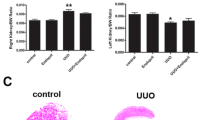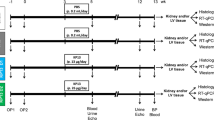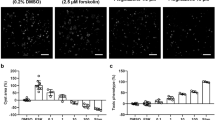Abstract
Angiotensin converting enzyme (ACE) inhibition is a common therapeutic modality in the treatment of autosomal recessive polycystic kidney disease (ARPKD). This study was designed to investigate whether chronic inhibition of ACE would have a therapeutic effect in attenuating the progression of renal cystogenesis in an orthologous rat model of ARPKD, the polycystic kidney (PCK) rat. Lisinopril (3 mg/kg per day) was administered orally for a period of 12 weeks, beginning at post-natal week 4. Lisinopril treatment resulted in an ∼30% improvement in the collecting duct cystic indices (CT CI) of PCK animals. Activation of extracellular signal-regulated kinase 1 (ERK1) and 2 (ERK2), proliferative signaling markers, and proliferating cell nuclear antigen (PCNA), an end-point marker for proliferation, was reduced following chronic treatment with lisinopril compared to that in vehicle-treated PCK rats. To assess whether apoptotic pathways were altered due to chronic ACE inhibition, we examined p38 mitogen activated protein kinase (MAPK) and stress-activated protein kinase/c-Jun N-terminal kinase (SAPK/JNK), which are markers of apoptotic signaling cascades. p38 MAPK was significantly reduced (P < 0.0001) following chronic treatment with lisinopril, but no change in the activation of SAPK/JNK could be detected by immunoblot analysis. Lisinopril treatment resulted in a significant reduction (P < 0.01) in cleaved caspase-7 levels, but not caspase-3 activity, in PCK rat kidneys compared to the vehicle-treated PCK rat kidneys. Proteinuria was completely ameliorated in the presence of chronic ACE inhibition in the lisinopril-treated rats compared with the vehicle-treated PCK rats. In all, these findings demonstrated that chronic ACE inhibition can beneficially alter proliferative and apoptotic pathways to promote therapeutic reductions in renal cyst development in ARPKD.






Similar content being viewed by others
References
Sweeney WE Jr, Avner ED (2006) Molecular and cellular pathophysiology of autosomal recessive polycystic kidney disease (ARPKD). Cell Tissue Res 326:671–685
Onuchic LF, Furu L, Nagasawa Y, Hou X, Eggermann T, Ren Z, Bergmann C, Senderek J, Esquivel E, Zeltner R, Rudnik-Schoneborn S, Mrug M, Sweeney W, Avner ED, Zerres K, Guay-Woodford LM, Somlo S, Germino GG (2002) PKHD1, the polycystic kidney and hepatic disease 1 gene, encodes a novel large protein containing multiple immunoglobulin-like plexin-transcription-factor domains and parallel beta-helix 1 repeats. Am J Hum Genet 70:1305–1317
Ward CJ, Hogan MC, Rossetti S, Walker D, Sneddon T, Wang X, Kubly V, Cunningham JM, Bacallao R, Ishibashi M, Milliner DS, Torres VE, Harris PC (2002) The gene mutated in autosomal recessive polycystic kidney disease encodes a large, receptor-like protein. Nat Genet 30:259–269
Bonnet F, Cao Z, Cooper ME (2001) Apoptosis and angiotensin II: yet another renal regulatory system? Exp Nephrol 9:295–300
Lautrette A, Li S, Alili R, Sunnarborg SW, Burtin M, Lee DC, Friedlander G, Terzi F (2005) Angiotensin II and EGF receptor cross-talk in chronic kidney diseases: a new therapeutic approach. Nat Med 11:867–874
Ushio-Fukai M, Alexander RW, Akers M, Griendling KK (1998) p38 Mitogen-activated protein kinase is a critical component of the redox-sensitive signaling pathways activated by angiotensin II. Role in vascular smooth muscle cell hypertrophy. J Biol Chem 273:15022–15029
Zhuo JL, Li XC (2007) Novel roles of intracrine angiotensin II and signalling mechanisms in kidney cells. J Renin Angiotensin Aldosterone Syst 8:23–33
Balbi AP, Francescato HD, Marin EC, Costa RS, Coimbra TM (2009) Roles of mitogen-activated protein kinases and angiotensin II in renal development. Braz J Med Biol Res 42:38–43
Calvet JP (2008) Strategies to inhibit cyst formation in ADPKD. Clin J Am Soc Nephrol 3:1205–1211
Kumar S, Boehm J, Lee JC (2003) p38 MAP kinases: key signalling molecules as therapeutic targets for inflammatory diseases. Nat Rev Drug Discov 2:717–726
Schaeffer HJ, Weber MJ (1999) Mitogen-activated protein kinases: specific messages from ubiquitous messengers. Mol Cell Biol 19:2435–2444
Nakanishi K, Sweeney WE Jr, Macrae Dell K, Cotton CU, Avner ED (2001) Role of CFTR in autosomal recessive polycystic kidney disease. J Am Soc Nephrol 12:719–725
Richards WG, Sweeney WE, Yoder BK, Wilkinson JE, Woychik RP, Avner ED (1998) Epidermal growth factor receptor activity mediates renal cyst formation in polycystic kidney disease. J Clin Invest 101:935–939
Sweeney WE Jr, Kusner L, Carlin CR, Chang S, Futey L, Cotton CU, Dell KM, Avner ED (2001) Phenotypic analysis of conditionally immortalized cells isolated from the BPK model of ARPKD. Am J Physiol Cell Physiol 281:C1695–C1705
Park F, Sweeney WE Jr, Jia G, Akbulut T, Mueller B, Falck JR, Birudaraju S, Roman RJ, Avner ED (2009) Chronic blockade of 20-HETE synthesis reduces polycystic kidney disease in an orthologous rat model of ARPKD. Am J Physiol Renal Physiol 296:F575–F582
Lager DJ, Qian Q, Bengal RJ, Ishibashi M, Torres VE (2001) The pck rat: a new model that resembles human autosomal dominant polycystic kidney and liver disease. Kidney Int 59:126–136
Guay-Woodford LM, Desmond RA (2003) Autosomal recessive polycystic kidney disease: the clinical experience in North America. Pediatrics 111:1072–1080
Zerres K, Rudnik-Schoneborn S, Deget F, Holtkamp U, Brodehl J, Geisert J, Scharer K (1996) Autosomal recessive polycystic kidney disease in 115 children: clinical presentation, course and influence of gender. Acta Paediatr 85:437–445
Zerres K, Rudnik-Schoneborn S, Senderek J, Eggermann T, Bergmann C (2003) Autosomal recessive polycystic kidney disease (ARPKD). J Nephrol 16:453–458
Capisonda R, Phan V, Traubuci J, Daneman A, Balfe JW, Guay-Woodford LM (2003) Autosomal recessive polycystic kidney disease: outcomes from a single-center experience. Pediatr Nephrol 18:119–126
Kaplan BS, Fay J, Shah V, Dillon MJ, Barratt TM (1989) Autosomal recessive polycystic kidney disease. Pediatr Nephrol 3:43–49
Keith DS, Torres VE, Johnson CM, Holley KE (1994) Effect of sodium chloride, enalapril, and losartan on the development of polycystic kidney disease in Han:SPRD rats. Am J Kidney Dis 24:491–498
Kennefick TM, Al-Nimri MA, Oyama TT, Thompson MM, Kelly FJ, Chapman JG, Anderson S (1999) Hypertension and renal injury in experimental polycystic kidney disease. Kidney Int 56:2181–2190
Zafar I, Tao Y, Falk S, McFann K, Schrier RW, Edelstein CL (2007) Effect of statin and angiotensin-converting enzyme inhibition on structural and hemodynamic alterations in autosomal dominant polycystic kidney disease model. Am J Physiol Renal Physiol 293:F854–F859
Chapman AB, Gabow PA (1997) Hypertension in autosomal dominant polycystic kidney disease. Kidney Int Suppl 61:S71–S73
Chapman AB, Johnson A, Gabow PA, Schrier RW (1990) The renin-angiotensin-aldosterone system and autosomal dominant polycystic kidney disease. N Engl J Med 323:1091–1096
Masoumi A, Reed-Gitomer B, Kelleher C, Bekheirnia MR, Schrier RW (2008) Developments in the management of autosomal dominant polycystic kidney disease. Ther Clin Risk Manag 4:393–407
Phillips JK, Hopwood D, Loxley RA, Ghatora K, Coombes JD, Tan YS, Harrison JL, McKitrick DJ, Holobotvskyy V, Arnolda LF, Rangan GK (2007) Temporal relationship between renal cyst development, hypertension and cardiac hypertrophy in a new rat model of autosomal recessive polycystic kidney disease. Kidney Blood Press Res 30:129–144
Hida M, Omori S, Awazu M (2002) ERK and p38 MAP kinase are required for rat renal development. Kidney Int 61:1252–1262
Omori S, Hida M, Fujita H, Takahashi H, Tanimura S, Kohno M, Awazu M (2006) Extracellular signal-regulated kinase inhibition slows disease progression in mice with polycystic kidney disease. J Am Soc Nephrol 17:1604–1614
Ecder T, Melnikov VY, Stanley M, Korular D, Lucia MS, Schrier RW, Edelstein CL (2002) Caspases, Bcl-2 proteins and apoptosis in autosomal-dominant polycystic kidney disease. Kidney Int 61:1220–1230
Tao Y, Kim J, Faubel S, Wu JC, Falk SA, Schrier RW, Edelstein CL (2005) Caspase inhibition reduces tubular apoptosis and proliferation and slows disease progression in polycystic kidney disease. Proc Natl Acad Sci U S A 102:6954–6959
Tao Y, Kim J, Stanley M, He Z, Faubel S, Schrier RW, Edelstein CL (2005) Pathways of caspase-mediated apoptosis in autosomal-dominant polycystic kidney disease (ADPKD). Kidney Int 67:909–919
Tao Y, Zafar I, Kim J, Schrier RW, Edelstein CL (2008) Caspase-3 gene deletion prolongs survival in polycystic kidney disease. J Am Soc Nephrol 19:749–755
Cowley BD Jr (2008) Calcium, cyclic AMP, and MAP kinases: dysregulation in polycystic kidney disease. Kidney Int 73:251–253
Earnshaw WC, Martins LM, Kaufmann SH (1999) Mammalian caspases: structure, activation, substrates, and functions during apoptosis. Annu Rev Biochem 68:383–424
Shi Y (2002) Mechanisms of caspase activation and inhibition during apoptosis. Mol Cell 9:459–470
Wolf BB, Green DR (1999) Suicidal tendencies: apoptotic cell death by caspase family proteinases. J Biol Chem 274:20049–20052
Veis DJ, Sorenson CM, Shutter JR, Korsmeyer SJ (1993) Bcl-2-deficient mice demonstrate fulminant lymphoid apoptosis, polycystic kidneys, and hypopigmented hair. Cell 75:229–240
Kaariainen H, Koskimies O, Norio R (1988) Dominant and recessive polycystic kidney disease in children: evaluation of clinical features and laboratory data. Pediatr Nephrol 2:296–302
Chapman AB, Guay-Woodford LM, Grantham JJ, Torres VE, Bae KT, Baumgarten DA, Kenney PJ, King BF Jr, Glockner JF, Wetzel LH, Brummer ME, O'Neill WC, Robbin ML, Bennett WM, Klahr S, Hirschman GH, Kimmel PL, Thompson PA, Miller JP (2003) Renal structure in early autosomal-dominant polycystic kidney disease (ADPKD): The Consortium for Radiologic Imaging Studies of Polycystic Kidney Disease (CRISP) cohort. Kidney Int 64:1035–1045
Chapman AB, Johnson AM, Gabow PA, Schrier RW (1994) Overt proteinuria and microalbuminuria in autosomal dominant polycystic kidney disease. J Am Soc Nephrol 5:1349–1354
Ecder T, Edelstein CL, Fick-Brosnahan GM, Johnson AM, Chapman AB, Gabow PA, Schrier RW (2001) Diuretics versus angiotensin-converting enzyme inhibitors in autosomal dominant polycystic kidney disease. Am J Nephrol 21:98–103
Acknowledgements
The authors would like to thank Dr. Kevin R. Regner for his scientific insight in this manuscript, and Ms. Lisa Henderson and Jenifer Goepfert for their excellent technical expertise in the blood analysis. The research in this manuscript was funded in part by The PKD Foundation (F.P.), Advancing a Healthier Wisconsin (F.P.), the American Heart Association (V.N.) and institutional departmental laboratory start-up funds (F.P. and V.N.).
Author information
Authors and Affiliations
Corresponding author
Rights and permissions
About this article
Cite this article
Jia, G., Kwon, M., Liang, H.L. et al. Chronic treatment with lisinopril decreases proliferative and apoptotic pathways in autosomal recessive polycystic kidney disease. Pediatr Nephrol 25, 1139–1146 (2010). https://doi.org/10.1007/s00467-010-1477-2
Received:
Revised:
Accepted:
Published:
Issue Date:
DOI: https://doi.org/10.1007/s00467-010-1477-2




